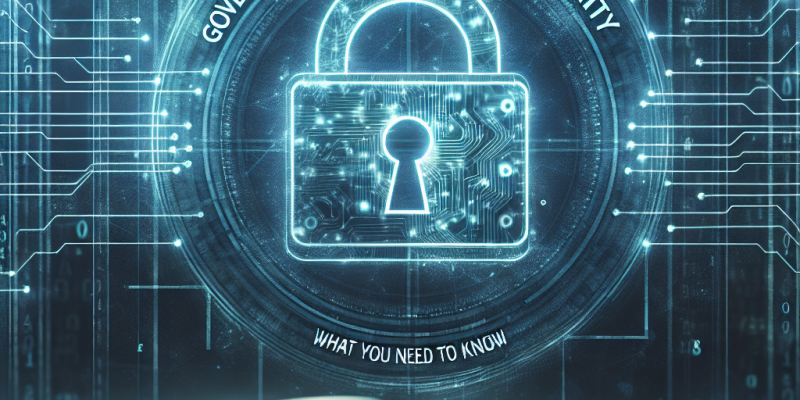Government Regulations on Cybersecurity: What You Need to Know

In today’s digitally-driven world, cybersecurity is more critical than ever. As cyber threats continue to evolve, governments worldwide are stepping up to establish frameworks and regulations aimed at protecting sensitive information and critical infrastructure. Understanding these regulations is essential for organizations seeking to comply and safeguard their assets. This article delves into the current landscape of government regulations on cybersecurity, highlighting key updates and essential considerations.
The Evolving Regulatory Landscape
Increased Legislative Focus
In response to growing cyber threats, governments are intensifying their legislative efforts. The past few years have seen numerous bills introduced that aim to bolster cybersecurity standards across various sectors. For instance, the Cybersecurity Improvement Act of 2021 in the United States mandates that federal agencies adopt cybersecurity best practices, highlighting the importance of baseline protection measures.
Sector-Specific Regulations
Different sectors are subject to tailored regulations based on their specific risks and the sensitivity of the data they handle:
-
Financial Sector: The Gramm-Leach-Bliley Act (GLBA) and the Payment Card Industry Data Security Standard (PCI DSS) impose strict cybersecurity requirements on financial institutions.
-
Healthcare: The Health Insurance Portability and Accountability Act (HIPAA) requires healthcare organizations to implement robust safeguards to protect patient information.
-
Energy and Utilities: The North American Electric Reliability Corporation (NERC) sets stringent cybersecurity standards to protect critical infrastructure within the electricity sector.
-
Government Contractors: The Cybersecurity Maturity Model Certification (CMMC) framework requires defense contractors to meet specific cybersecurity standards to protect government data.
Recent Updates in Regulations
1. CISA Initiatives
The Cybersecurity and Infrastructure Security Agency (CISA) has taken a proactive role in enhancing national cybersecurity strategies. Recent updates include:
-
Cybersecurity Strategy 2023: Aimed at strengthening public-private collaboration, this strategy emphasizes information sharing and collective defense against cyber threats.
-
Incident Reporting Requirements: Recent mandates require certain organizations to report cybersecurity incidents and breaches within specified timelines, helping to facilitate timely responses and investigations.
2. EU GDPR and Updates
The General Data Protection Regulation (GDPR), enacted in the European Union, continues to influence global cybersecurity policies. Notable updates include:
-
Stricter Penalties: Organizations that fail to comply with GDPR face hefty fines, incentivizing businesses to improve data protection measures.
-
Data Breach Notifications: GDPR mandates that organizations notify authorities and affected individuals within 72 hours of a data breach, emphasizing urgency in response efforts.
3. California Consumer Privacy Act (CCPA)
California’s CCPA, which took full effect in 2020, has significant implications for data privacy and cybersecurity:
-
Expanded Consumer Rights: Consumers now have the right to know what personal data is being collected, how it’s used, and to whom it’s sold, aligning cybersecurity efforts with consumer privacy rights.
-
Enforced Compliance: Organizations failing to meet CCPA requirements can incur significant penalties, highlighting the importance of robust cybersecurity practices.
Strategies for Compliance
Navigating the regulatory landscape can be daunting. Here are some strategies organizations can adopt to ensure compliance:
1. Conduct Regular Risk Assessments
Regularly assess cybersecurity risks to identify vulnerabilities and ensure compliance with relevant regulations. This proactive approach can highlight areas for improvement and help mitigate potential threats.
2. Implement Comprehensive Security Policies
Develop and implement comprehensive security policies that adhere to the latest regulatory standards. This includes employee training on data protection practices and incident response protocols.
3. Monitor Regulatory Changes
Staying updated on regulatory changes is crucial. Subscribing to industry newsletters, attending relevant workshops, and participating in forums can help organizations remain informed.
4. Engage Legal and Compliance Experts
Consulting with legal and compliance experts can provide valuable insights into navigating complex regulations and ensuring that organizational practices align with legal requirements.
Conclusion
Government regulations on cybersecurity are evolving rapidly, driven by the increasing frequency and sophistication of cyber threats. Organizations must stay informed about these changes to ensure compliance and protect sensitive data. By implementing comprehensive security measures and actively engaging with regulatory developments, businesses can safeguard themselves against the risks posed by cyber threats. In this digital age, proactive cybersecurity is not just an option; it’s a necessity.














